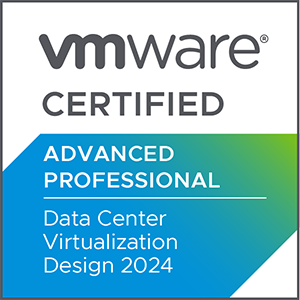
VMware vSphere Design 8
Nosta VMware vSphere ympäristöjen suunnittelutaitosi seuraavalle tasolle. VMware vSphere Design 8 kurssilla opit suunnittelemaan, mitoittamaan ja määrittelemään VMware vSphere ympäristöjä. Samalla opit myös muuhun käyttöön sopivia tehokkaita suunnittelu, määrittely ja dokumentointimenetelmiä. Käsittelemme myös kokonaisarkkitehtuuria ja sen määrittely ja kuvaus menetelmiä kuten Togaf ja Zachman.
Huom. tällä VMware vSphere: Design -kurssilla ei toteuteta määrityksiä vaan suunnitellaan ympäristö ja sille parhaat mahdolliset määritykset, siksi kurssi harjoitukset ovat ’kynä ja paperi’ / Word ja Excel -harjoituksia. Mitään ns. VMware Lab ympäristöä ei kurssissa käytetä.
Kurssi painottuu kouluttajan johdolla tapahtuviin yhteisiin keskusteluihin harjoituksissa määriteltyjen tavoitteiden parhaaksi ratkaisuksi.
Kurssin vetäjänä toimii pitkäaikainen VMware vSphere -ammattilainen, VCI, VCIX, VCAP Pertti Pellonpoika. Opetus on suomeksi.
Kouluttaja täydentää tällä kurssilla VMware materiaalia omalla syventävällä materiaalilla tarpeen mukaan.


Kurssilla saamasi taidot
Kursin jälkeen sinulla on tarvittavat taidot suunnitella, mitoittaa ja tehdä määrittelyt kuhunkin ympäristöön parhaan mahdollisen VMware vSphere ympäristön luomiseksi sekä edellytykset VCAP-DCV Design -testiin.
Kurssin jälkeen sinulla on erityisesti seuraavat taidot:
• Create a vSphere design given a case study
• Identify the business objectives for the vSphere environment
• Identify business requirements, constraints, assumptions, and risks for all layers in the vSphere environment
• Apply a framework to a design
• Analyze design choices for vCenter, ESXi, storage, networking, vSphere clusters, and virtual machines
• Identify design decisions to ensure manageability, which include scalability, capacity planning and lifecycle management
• Identify design decisions to ensure that the vSphere environment is highly available
• Identify design decisions to ensure that the vSphere environment performs well
• Identify design decisions to ensure that the vSphere environment is secure
• Identify design decisions to ensure that the vSphere environment can recover from data loss or disaster
Kenelle ja esivaatimukset
Kurssi on tarkoitettu erityisesti arkkitehdeille ja konsulteille (tai sellaiseksi aikovalle), mutta myös kaikille, jotka osallistuvat omien VMware vSphere ympäristöjen käyttöönottoihin. Erityisesti kurssi sopii myös VCAP-DCV Design sertifiointiin tähtääville.
Tämän kurssin esivaatimuksena on hyvä käytännön kokemus tai VMware kursseista suoritettuna VMware vSphere: Fast Track tai VMware vSphere: Operate, Scale and Secure. Kurssi sopii myös erityisesti VCP-DCV sertifioinnin suorittaneille jatkokurssiksi.
Koulutuksen sisältö
1 Course Introduction
- Introductions and course logistics
- Course objectives
2 Infrastructure Assessment
- Describe various design framework principles
- Follow a proven process to design a virtualization solution
- Define customer business objectives and requirements
- Use a systematic method to evaluate and document a conceptual model
- Create a logical design from a conceptual model
- Recognize key information contained in the physical design
3 Designing for Manageability: Capacity Planning
- Make capacity planning design decisions that adhere to business requirements
- Design capacity planning strategies that meet the needs of the vSphere environment and follow VMware best practices
- Calculate compute and storage requirements for the VMs in the vSphere environment
4 Designing for Manageability: Scalability
- Make scalability design decisions that adhere to business requirements
- Design scalability strategies that meet the needs of the vSphere environment and follow VMware best practices
5 Designing for Manageability: Lifecycle Management
- Make lifecycle management design decisions that adhere to business requirements
- Design lifecycle management strategies that meet the needs of the vSphere environment and follow VMware best practices
6 Designing for Availability
- Make availability design decisions that adhere to business requirements
- Design availability strategies that meet the needs of the vSphere environment and follow VMware best practices
7 Designing for Performance
- Make performance design decisions that adhere to business requirements
- Design performance strategies that meet the needs of the vSphere environment and follow VMware best practices
8 Designing for Security
- Make security design decisions that adhere to business requirements
- Design security strategies that meet the needs of the vSphere environment and follow VMware best practices
9 Designing for Recoverability
- Make recoverability design decisions that adhere to business requirements
- Design recoverability strategies that meet the needs of the vSphere environment and follow VMware best practices
Testi ja sertifiointi
Tämä kurssi valmentaa hyvin VMware vSphere 8.x Advanced Design (3V0-21.23) -testiin, jolla saavutat VMware Certified Advanced Professional – Data Center Virtualization (VCAP-DCV) Design sertifioinnin.